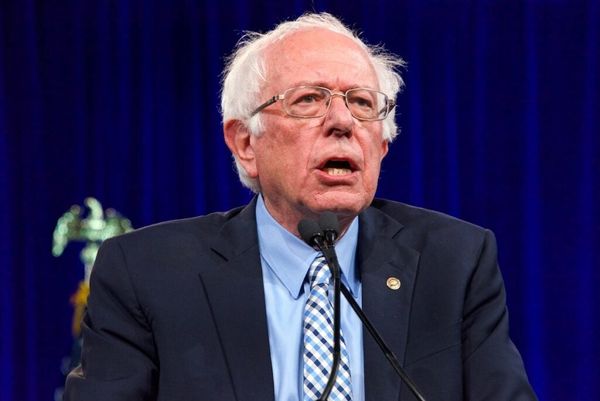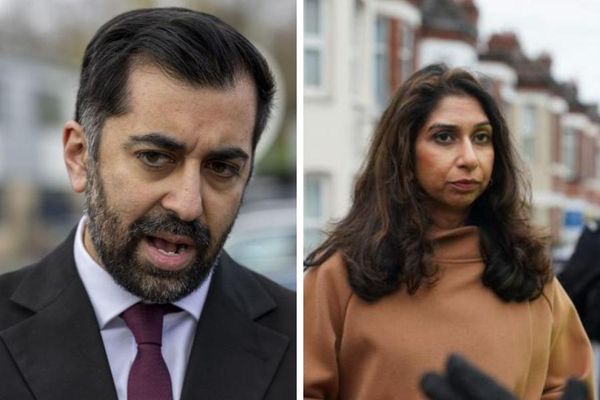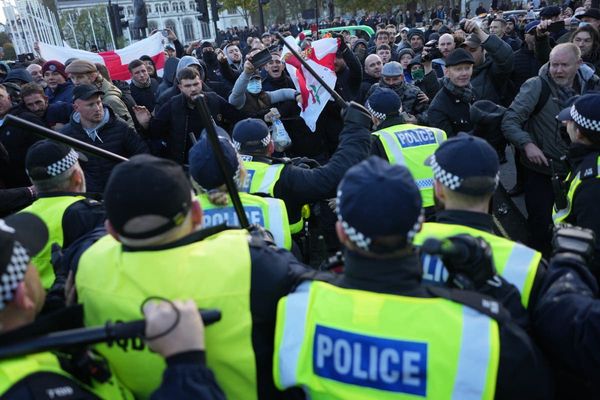
Much of the UK government’s reaction to disorder in London on Armistice Day, as well as some media coverage, have suggested that blame was shared equally between those on the pro-Palestinian march of at least 300,000 people and those who joined the much smaller, far-right counterprotest. But on-the-ground reporting, footage of events, and police accounts from the weekend suggest that this is misleading, and that the significant trouble that unfolded was largely the responsibility of the far right.
Here’s a summary of the claims and the evidence so far.
The claims: ‘extremists from ALL sides’
Suella Braverman – sacked on Monday morning as home secretary – had cut an isolated figure in the cabinet after accusing the police of being biased in favour of the marchers, but broke her silence on the disorder on Sunday afternoon in a series of tweets. She made a fleeting reference to “protesters and counter-protesters”, but had nothing specific to add on the latter, instead focusing on “the sick, inflammatory and, in some cases, clearly criminal chants, placards and paraphernalia openly on display at the march”.
Rishi Sunak’s version of what happened was reported in the Sunday Telegraph’s front page headline: “Far-right thugs and Hamas sympathisers disrespect our heroes”. He condemned “the violent, wholly unacceptable scenes we have seen today from the EDL and associated groups and Hamas sympathisers attending the National March for Palestine”. He noted that the majority had “chosen to express their views peacefully”, but his statement appeared to present groups on both sides as equally culpable.
The Mail on Sunday, meanwhile, described “terrifying scenes as extremists from ALL sides tarnish Armistice Day”. But it led on an incident involving the cabinet minister Michael Gove, who it said was “jostled and abused” by a “pro-Palestine hate mob”. The first mention of the far right came in the 10th paragraph on an inside page. A full-page editorial, meanwhile, described “outrages by the apostles of violence”. The counter-protest first appeared 750 words in, in a sentence suggesting that the protest organisers “ought to take some part of the responsibility”.

Something similar was visible in several of this morning’s papers. An editorial in the Sun said the pro-Palestine march gave the far right “the excuse to act” and largely focused on how march organisers “ducked their responsibilities”. The Daily Mail suggested that what took place on the march was “more overtly far-Right than a few dozen football hooligans scuffling with police”.
The march: ‘There was no sense of a violent dynamic’
There is no doubt that there were incidents of antisemitism and disorder on the march and among breakaway groups. On Sunday, the Met released photos of six people it said it was seeking to identify in relation to a hate crime, including one woman holding a banner depicting a swastika intertwined with the star of David. There was footage of another woman at Victoria station shouting “death to all the Jews”, and another of a man on the march telling an interviewer that “Hitler knew how to deal with these people”.
The police also temporarily detained about 150 people who broke away from the main march and set off fireworks. No one was arrested. The Campaign Against Antisemitism said families leaving a synagogue in St John’s Wood were escorted away by police after men waving Palestinian flags shouted at them from cars outside.
Ben Jamal, the director of the Palestine Solidarity Campaign (PSC), said he had counted 10 incidents pictured on social media, and I’ve reached the same tally of photos from the main march. Others may emerge in the coming days (and I may have missed some), but among 300,000 people, according to police estimates, or 800,000 according to organisers, it is hard to see those incidents as characteristic. (This is not to discount their impact on those Jewish people who have seen the weekly emergence of such cases as intimidating proof of antisemitism.)
Mark Townsend, who covered the march and the counterprotest for the Observer, said the overwhelming atmosphere was peaceful. “There were lots of families, it felt like the dominant demographic was women in their 20s,” he said. “The number of arrests was tiny against the size of the march. There was no sense, in what I saw, of a violent dynamic at all. Even when the far right were getting very close, there was a bit of chests-out defensive stuff among some of the men, but no sense of seeking to take them on.”
In part, he attributes the behaviour of the vast majority to “a sense that everyone was on best behaviour, knowing that the spotlight was on. There were a lot of people saying, we have to send a message, and that message is peace”.
The counter-protest: ‘They were looking for a fight’
There was no sense, in contrast, of a moderate mainstream to the counter-protest, which was almost exclusively made up of white men who appeared to have come to London in search of trouble. Telegram groups popular with the English Defence League and the Democratic Football Lads Alliance had organised their attendance, Townsend said. “You could tell when they arrived that they were tanked-up – that they were treating it as they would an away match at a formidable football ground. They were looking for a fight immediately. There was more hostility than I’ve seen on EDL marches in the past.”
Counterprotesters who spoke to Townsend claimed Braverman was “the only one listening to us”. Whatever Braverman meant, a line in her Times article about “the tough way [football fans] are policed” was understood as a sign of her tacit support. “They have plenty of previous with the police from being herded at football matches,” Townsend said.
The police said the vast majority of arrests were of the counter-protesters, despite their far smaller relative numbers - estimated at about 1,000. Videos abound of large groups seeking confrontation with the police, chanting “you’re not English any more” at officers in Chinatown or throwing glass bottles. One video shows a group of men at Waterloo station calling someone a “terrorist” and saying “we were born in this country”. Another video showed a group chanting “who the fuck is Allah” at the protesters, many of whom were Muslims. Assistant Met commissioner Matt Twist said they had committed “extreme violence” and were found in possession of weapons including a knife, a baton and a knuckleduster, as well as Class A drugs. Nine officers were injured in clashes with counter-protesters, and at least two are in hospital.

Perhaps the most striking incident, though, was when far-right protesters charged past police who sought to hold them back from the Cenotaph. In this video, a man shouts “this is fucking our country” in celebration. Whereas the pro-Palestine march had been excluded from the area as a precaution, the far right was not; by overwhelming the police, they supposedly sought to defend the site from an enemy that simply wasn’t there.
All in all, Townsend said, “the Met did a brilliant job at policing the march and maintaining order”. But while both sides needed to be policed, the claims that both bear equal responsibility for what unfolded appear fatuous. “To draw that equivalence is beyond sleight of hand – it’s disingenuous,” Townsend added. “Anyone airbrushing the difference has got it very wrong – or they’re politically motivated.”










